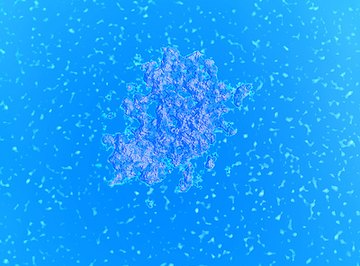
Aerobic respiration and fermentation are two processes which are used to provide energy to cells. In aerobic respiration, carbon dioxide, water, and energy in the form of adenosine triphosphate (ATP) is produced in the presence of oxygen. Fermentation is the process of energy production in the absence of oxygen. The products of each process may be either lactic acid and nicotinimide adenine dinucleotide, or ethanol, carbon dioxide and nicotinimide adenine dinucleotide (NAD+), depending on whether the process is lactic acid fermentation of alcoholic fermentation. Fermentation is more common to primitive organisms that lived before the creation of oxygen in the atmosphere. Although aerobic respiration and fermentation possess many similarities--such as the occurrence of both processes after that of glycolysis, and the end result of energy uptake by the cells--they do possess distinctive differences. It's easier to distinguish between aerobic respiration and fermentation when you understand the organisms that carry out these processes, the conditions under which the processes occur, the sequence of the reactions and the products of the reactions.
- Books
- Computer
- Pen
- Paper
To remember the distinctions between aerobic respiration and fermentation, write out their differences. It will serve as a good form of organization.
Obtain an understanding of the organisms that carry out aerobic respiration, and those that undergo fermentation. You can distinguish between aerobic respiration and fermentation by understanding which organisms perform which processes. Fermentation was the first process to occur during the course of evolution because the atmosphere did not originally contain oxygen. Therefore, organisms had to find a way to obtain energy without its presence. In primitive conditions, only microorganisms were present. The main organisms that carry out fermentation are yeast and bacteria. The muscle cells of humans can undergo lactic acid fermentation. However, humans mainly employ oxygen to derive their cellular energy. Aerobic respiration is the process that represents the progress associated with evolution in complex organisms.
Analyze the conditions under which the processes of aerobic respiration and fermentation occur. Remember that aerobic respiration occurs in the process of oxygen, whereas fermentation does not. To better understand this, remember that muscle cells typically undergo lactic acid fermentation when not enough oxygen is being supplied, yet energy is needed.
Comprehend the steps that are involved in each of the processes. You can distinguish between aerobic respiration and fermentation by understanding which main events are present within each of the processes. Aerobic respiration involves two separate main events in order to produce the products. The first step involves the creation of ATP and carbon dioxide, while the second step involves the creation of water. Fermentation is a simpler process that produces the products within a single step. In lactic acid fermentation, this corresponds to the creation of NAD+ and lactic acid. In alcoholic fermentation, this corresponds to the creation of ethanol, carbon dioxide and NAD+.
Analyze the products of the reactions. While aerobic respiration and fermentation both produce energy, the products of the processes are in different forms. The products of aerobic respiration are carbon dioxide, water, and energy in the form of ATP. The products of lactic acid fermentation are lactic acid and NAD+. The products of alcoholic fermentation are carbon dioxide, ethanol and NAD+.
Things You'll Need
Tips
Tips
- To remember the distinctions between aerobic respiration and fermentation, write out their differences. It will serve as a good form of organization.
About the Author
Mara Pesacreta has been writing for over seven years. She has been published on various websites and currently attends the Polytechnic Institute of New York University.
Photo Credits
bacteria image by chrisharvey from Fotolia.com
